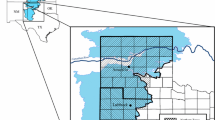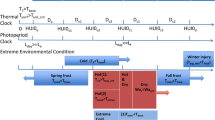Abstract
Farmers in the North Central region of the United States often are reluctant to use shelterbelts because of inadequate information clearly showing their benefits. We developed a computer model, called SBELTS for ShelterBELT and Soybeans, that simulates the influence of a shelterbelt on soybean (Glycine max L.) production across an agricultural field in the midwestern United States. Objectives of this study were to 1) describe the structure of SBELTS, 2) present model simulations, and 3) discuss model limitations. SBELTS is composed of three submodels. The first submodel produces characteristics of a shelterbelt that are passed to the second submodel that estimates daily windrun at user-specified distances leeward (away from the prevailing wind) of the shelterbelt. Estimated daily windruns are merged with other microclimatic information to produce weather files for each specified distance. Finally, the third submodel uses a soybean growth/yield model to estimate soybean yield at specified distances, and the yields are averaged. Data collection was not a part of the present project, so SBELTS was evaluated by comparing predicted results with published information. SBELTS was used to predict soybean yield across a field leeward of a 7.6 m tall shelterbelt, and the predicted yield curve compared well with published yield curves. The sensitivity of SBELTS to variation in rainfall was evaluated by predicting yields for 3.8 m tall and 7.6 m tall shelterbelts in wet, normal, and dry years. Results showed no shelterbelt influence in wet years, some influence in normal years, and a sizable influence in dry years. Results showed that the 7.6 m shelterbelt had more influence than the 3.8 m shelterbelt. Although SBELTS has limited use, it is the first step in the development of more advanced models that will be able to simulate production of soybeans and other crops under the influence of shelterbelts on a variety of soil types.
Similar content being viewed by others
References
Batchelor WD, Zeiss MR, Pedigo LP and Shibles RM (1997) Development of a model to predict soybean pod color distribution. Trans. ASAE 40: 221-227
Brandle JR, Johnson B and Akeson T (1992) Field windbreaks: are they economical? J Prod Agric 5: 393-398
Brown KW and Rosenberg NJ (1972) Shelter-effects on microclimate, growth and water use by irrigated sugar beets in the Great Plains. Agric Meteorol 9: 241-263
Doorenbos J and Pruitt WO (1975) Irrigation and drainage paper # 24. I: Guidelines for predicting crop water requireements. FAO, Rome
Grace J (1988) Plant response to wind. Agric, Ecos and Environ 22/23: 71-88
Hoogenboom G, Jones JW, Wilkens P, Batchelor W, Bowen W, Hung L, Pickering N, Singh U, Godwin D, Baer B, Boote K, Ritchie J and White J (1994) Tsuji GY, Uehara G and Balas S (eds.), DSSAT v3, vol 2-2. University of Hawaii, Honolulu, Hawaii. pp 95-244
Kort J (1988) Benefits of windbreaks to field and forage crops. Agric, Ecos and Environ 22/23: 165-190
Litvina IV (1987) Meteorological recommendations for designing and using plant strips. Agrophysical Research Institute, St. Petersburg, Russia (in Russian), 41 pp
Litvina IV and Takle ES (1993) Designing shelterbelts by using a turbulence model. Proceedings, 4th International Symposium on Windbreaks and Agroforestry, 24-27. Viborg, Denmark
Marshall JK (1967) The effect of shelter on the productivity of grassland and field crops. Field Crop Abstr. 20: 1-14
Mayus M, Van Keulen H and Stroosnuder L (1999) A model of tree-crop competition for windbreak systems in the Sahel: description and evlauation. Agroforestry Systems 43(1): 183-201
Qi X (1998) Shelterbelt-soybean production model (SBELTS) PhD dissertation. Iowa State University, Ames, IA, 75 pp
Rosenberg NJ, Blad BL and Verma SB (1983) Microclimate-The biological environment. A Wiley-Interscience Publication, 495 pp
Sexton PJ, Batchelor WD, Boote KJ and Shibles RM (1998) Evaluation of CROPGRO for predication of soybean nitrogen balance in midwestern environment. Trans ASAE 41(5): 1543-1548
Shen J, Batchelor W, Jones J, Ritchie J, Kanwar R and Mize C (1998) Incorporation of a subsurface tile drainage component into a soybean growth model. Trans ASAE 41: 1305-1313
Stoeckeler JH (1972) Shelterbelt influence on Great Plains field environmental crops USDA Prod Res Rep No. 62, 26 pp
Van Eimern J (1959) The variability of wind protective effect of a double row of trees under various meteorological conditions. Rpt German Weather Serv No. 32, 46 pp
Van Eimern J, Karschon R, Razumova LA and Robertson GW (1964) Windbreaks and shelterbelts. World Meteor Org Tech Note No. 59, 67 pp
Wang H and Takle ES (1995) Boundary-layer flow and turbulence near porous obstacles. I. Derivation of a general equation set for a porous medium. Boundary-Layer Meteor 74: 73-88
Author information
Authors and Affiliations
Corresponding author
Rights and permissions
About this article
Cite this article
Qi, X., Mize, C.W., Batchelor, W.D. et al. SBELTS: A model of soybean production under tree shelter. Agroforestry Systems 52, 53–61 (2001). https://doi.org/10.1023/A:1010647118256
Issue Date:
DOI: https://doi.org/10.1023/A:1010647118256




